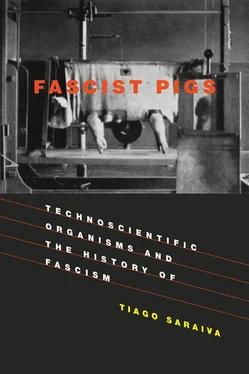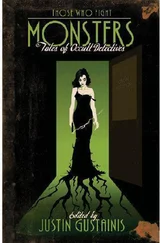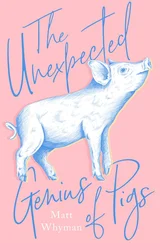Invitations from Shane Hamilton to a history seminar at the University of Georgia and from John Tresch to a workshop in history and sociology of science, medicine, and technology at the University of Pennsylvania were particularly useful. At the latter workshop, Robert Kohler was generous enough to engage in a deep and illuminating discussion on how fascist my pigs were.
A large part of the final manuscript was prepared while I was at the University of California at Berkeley as a visiting assistant professor at the kind invitation of Cathryn Carson. At UC Berkeley I had the privilege of discussing my research at length not only with Cathryn but also with Massimo Mazzotti, Carolyn Merchant, Thomas W. Laqueur, Brian Delay, and James Vernon.
Since starting at Drexel University in the fall of 2012, I have profited immensely from perceptive and critical readings by my colleague and friend Amy Slaton. Amy was patient and generous enough to work through every chapter of the book with me, pushing for bolder claims and more relevant arguments. The introduction benefited greatly from her exceptional scholarly talents. It has been a treat to sustain a daily conversation with another scholar who gets as excited as I do about the standardization processes of mundane things, be they pigs or cement, oranges or engineering curricula.
I have found at Drexel’s history department a distinctively collegial atmosphere, and I feel honored by the way its faculty members have welcomed me. I am particularly thanful to Donald Stevens, Kathryn Steen, Lloyd Ackert, Debjani Bhattacharya, Alden Young, Eric Brose, Jonson Miller, and Jonathan Seitz. Scott Gabriel Knowles has been an exceedingly encouraging presence in his triple role as department head, historian of technology, and friend. Melissa Mansfield always finds a way of graciously handling bureaucratic problems that otherwise might be insurmountable. Donna Murasko, as dean of the Drexel College of Arts and Sciences, has granted constant institutional support for my research.
I have learned more from interactions with my graduate students than they will ever suspect. I am genuinely moved by the decisions by Marta Macedo, Maria do Mar Gago, Blanca Uribe, and Isabel Bolas to trust me as their dissertation advisor. I am glad to admit that many of the findings presented in this book will soon be considered démodé as a result of their groundbreaking research on cocoa, coffee, cattle, and cement.
Finally, I want to express my deep gratitude to Francisco for urging me to accept the challenge of American academia, and to António for being willing to join me in the adventurous and demanding move to the United States. All this was only possible through Vanessa’s enduring love. When writing, there are always multiple interlocutors inside one’s head. The most interesting things readers might find in this book are due to Vanessa’s constant presence.
In 1935 Georges Canguilhem published a pamphlet titled Fascism and the Peasants, which he had written for the Vigilance Committee of Antifascist Intellectuals, a group formed by the Parisian intelligentsia in reaction to the fascist attempt of seizing political power in France one year earlier. [1] Georges Canguilhem, Il fascismo e i contadini (Il Mulino, 2007; first edition 1935). The Committee counted among its 6,000 members such famous figures as the philosopher Alain and the physicist Paul Langevin. On the committee, see N. Racine-Furlaud, “Le Comité de Vigilance des intellectuels antifascists (1934–1939). Antifascisme et pacifisme,” Le Mouvement social 101 (1977): 87–113. For a general overview of antifascist activities in interwar France, see Anson Rabinbach, “Paris, capital of anti-fascism,” in The Modernist Imagination: Intellectual History and Critical Theory: Essays in Honor of Martin Jay , ed. W. Breckman, P. E. Gordon, A. D. Moses, and S. Moyn (Berghahn, 2009).
That early work by one of the most distinguished figures in the venerable French tradition of historical epistemology warned against the fascist agrarian ideology represented in France by the Greenshirts and their leader, Henri Dorgères. [2] Robert O. Paxton, French Peasant Fascism: Henry Dorgère’s Greenshirts and the Crises of French Agriculture, 1929–1939 (Oxford University Press, 1997).
It made explicit that the Greenshirts’ back-to-the-land project—with its slogan “D’abord la terre!” (“The land first!”)—was in fact a very modern project that essentialized peasant culture and replaced the multiplicity of living things that thrived in the French countryside with normalized entities. Canguilhem denounced the Greenshirts as a fascist move to control peasants’ lives and subordinate them to a centralized state. [3] Canguilhem, Il fascismo , p. 129.
Michel Foucault, perhaps Canguilhem’s most influential commentator, noticed that it was no coincidence that several epistemologists were active antifascists and members of the French Resistance after Hitler’s invasion of the country in 1940. [4] See Foucault’s introduction to Georges Canguilhem’s book The Normal and the Pathological (Zone Books, 1989; first edition 1978).
Jean Cavaillés (the philosopher who founded the resistance network Libération), shot by the Nazis in 1944, was later celebrated by his colleague and friend Canguilhem as a “philosopher-mathematician loaded with explosives.” [5] Georges Canguilhem, Vie et mort de Jean Cavaillès (Allia, 1996); Jean-Pol-Droit, La Compagnie des Philosophes (Odile Jacob, 1998).
Canguilhem himself joined Libération in 1943 and fought as a partisan in the mountains of Auvergne. The continuity between secluded theoretical scholarly work and armed resistance against fascism was clear to Foucault: epistemologists, through their questioning of modes of reasoning, had a privileged understanding of fascism as a totalitarian attempt to control every dimension of life, an extreme case of biopolitics. [6] The word ‘biopolitics’ was first used by Michel Foucault to distinguish liberal states forms of power from those of Ancien Régime monarchies in his lectures at the Collège de France in 1976. See Foucault, Society Must Be Defended: Lectures at the Collège de France, 1975–76 (Penguin, 2003). Paul Rabinow and Nikolas Rose write: “While Foucault is somewhat imprecise in his use of the terms, within the field of biopower, we can use the term ‘biopolitics’ to embrace all the specific strategies and contestations over problematizations of collective human vitality, morbidity and mortality; over the forms of knowledge, regimes of authority and practices of intervention that are desirable, legitimate and efficacious.” (Rabinow and Rose, “Biopower today,” BioSocieties 1 (2006): 195–217) Rabinow and Rose’s discussion is an important corrective to the understanding of Nazi concentration camps as exemplary of biopolitics as explored in Giorgio Agamben’s influential book Homo Sacer: Sovereign Power and Bare Life (Stanford University Press, 1998).
If Canguilhem dealt with rationality through concepts such as “the pathological” and “resistance,” he could not avoid being on the front line against political regimes that promised to totally eliminate the chance of error, which, according to his views, constituted the possibility of life itself. The confrontation with fascism was thus central in establishing an epistemological tradition that questioned forms of thinking about and tinkering with life.
This book takes up that tradition to explore fascism as biopolitics. Building on Canguilhem’s and Foucault’s conviction that management and control of life were central to fascism, it follows an alternative track. [7] For an overview of the Nazi state’s racial and eugenic policies, see Michael Burleigh and Wolfgang Wippermann, The Racial State: Germany 1933–1945 (Cambridge University Press, 1991); Edouard Conte and Cornelia Essner, La Quête de la Race (Hachette, 1995); Peter Weingart, Jürgen Kroll, and Kurt Bayertz, Rasse, Blut und Gene: Geschichte der Eugenik und Rassenhygiene in Deutschland (Suhrkamp, 1988); Robert N. Proctor, Racial Hygiene: Medicine under the Nazis (Harvard University Press, 1988); Paul Weindling, Health, Race and German Politics between National Unification and Nazism, 1870–1945 (Cambridge University Press, 1993); Sheila Faith Weiss, The Nazi Symbiosis: Human Genetics and Politics in the Third Reich (University of Chicago Press, 2010). On the population politics of the fascist Italian regime, see Francesco Cassata, Building the New Man: Eugenics, Racial Science, and Genetics in Twentieth-Century Italy (Central European University Press, 2011); Victoria de Grazia, How Fascism Ruled Women: Italy, 1922–1945 (University of California Press, 1992); David Horn, Social Bodies: Science, Reproduction and Italian Modernity (Princeton University Press, 1994).
It investigates the making and growing of animals and plants embodying fascism. It details how technoscientific organisms designed to feed the national community envisaged by fascists became important elements in the institutionalization and expansion of the regimes of Mussolini, Salazar, and Hitler. The point is not to replace humans with non-humans in explanations of historical change, but to extend the notion of biopolitics and suggest that we must seriously integrate the latter in history to be able to understand how social collectives came into being and how they evolved. [8] Environmental historians have fully demonstrated the payoffs of placing animals at the forefront of historical narratives. See Harriet Ritvo, The Animal Estate: The English and Other Creatures in the Victorian Age (Harvard University Press, 1987); Harriet Ritvo, Noble Cows and Hybrid Zebras: Essays on Animals and History (University of Virginia Press, 2010); Elinor Melville, A Plague of Sheep: Environmental Consequences of the Conquest of Mexico (Cambridge University Press, 1997); Virginia DeJohn Anderson, Creatures of Empire: How Domestic Animals Transformed Early America (Oxford University Press, 2006); John Robert McNeill, Mosquito Empires: Ecology and War in the Greater Caribbean, 1620–1914 (Cambridge University Press, 2010); Alfred W. Crosby, Ecological Imperialism: The Biological Expansion of Europe, 900–1900 (Cambridge University Press, 1986); Ann Norton Greene, Horses at Work: Harnessing Power in Industrial America (Harvard University Press, 2008). Historians of technology have brought both animals and plants into the heart of their discipline in the important volume Industrializing Organisms: Presenting Evolutionary History , ed. S. R. Schrepfer and P. Scranton (Routledge, 2004). In STS, the work of Donna Haraway has been highly influential; see Simians, Cyborgs, and Women: The Reinvention of Nature (Free Association Books, 1991); Modest_witness@SecondMillenium.FemaleMan@Meets_OncoMouse TM (Routledge, 1997); When Species Meet (University of Minnesota Press, 2007). See also, in a similar vein, Sarah Franklin, Dolly Mixtures: The Remaking of Genealogy (Duke University Press, 2007). For an elaborated argument on why historians shouldn’t make much case of the traditional division between animals and plants, see Edmund Russell, Evolutionary History: Uniting History and Biology to Understand Life on Earth (Cambridge University Press, 2011). This is, of course, a highly contentious point for the scholarly field of animal studies. For an overall discussion of the field, see Kari Weil, Thinking Animals: Why Animal Studies Now? (Columbia University Press, 2012); Aaron Gross and Anne Vallely, eds., Animals and the Human Imagination: A Companion to Animal Studies (Columbia University Press, 2012); Tim Ingold, ed., What Is an Animal? (Routledge, 1988).
Fascist collectives were not only formed through the interventions in human life identified by Foucault and his disciples—hygiene, reproduction, and race. [9] Michel Foucault, The Birth of Biopolitics: Lectures at the Collège de France, 1978–1979 , ed. M. Senellart (Picador, 2008), p. 317.
They also included organisms that breeders of plants and animals produced through new practices of the sciences of heredity—life forms as important as human bodies in making fascism.
Читать дальше












